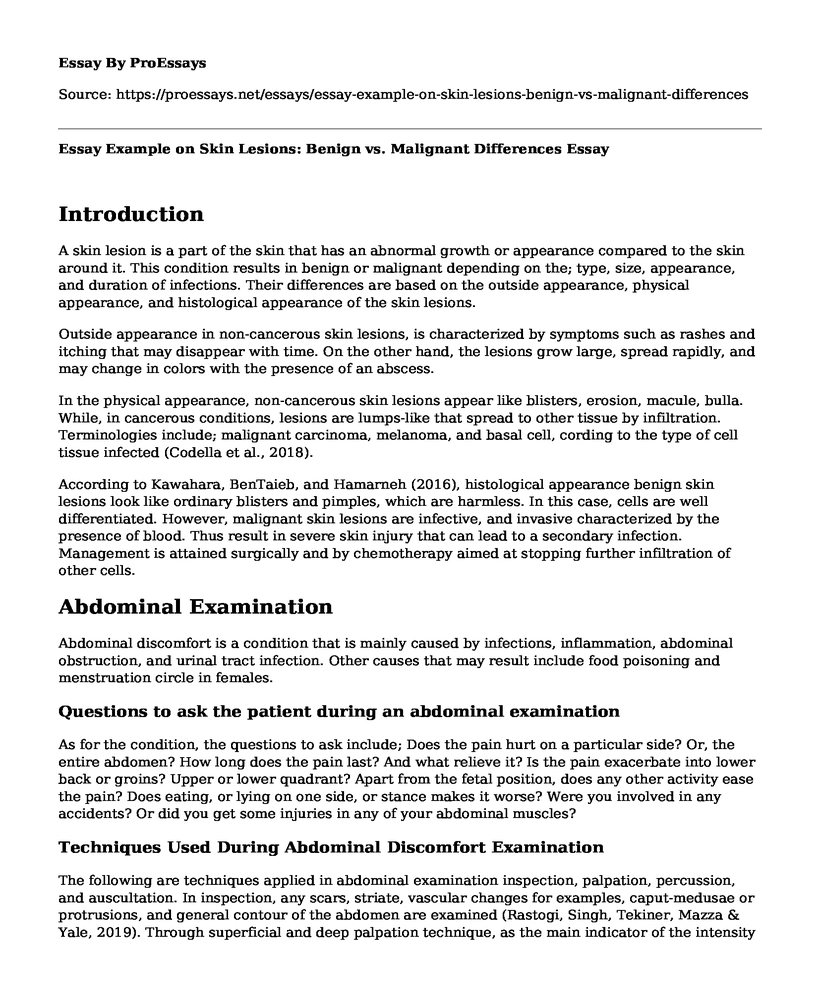Introduction
A skin lesion is a part of the skin that has an abnormal growth or appearance compared to the skin around it. This condition results in benign or malignant depending on the; type, size, appearance, and duration of infections. Their differences are based on the outside appearance, physical appearance, and histological appearance of the skin lesions.
Outside appearance in non-cancerous skin lesions, is characterized by symptoms such as rashes and itching that may disappear with time. On the other hand, the lesions grow large, spread rapidly, and may change in colors with the presence of an abscess.
In the physical appearance, non-cancerous skin lesions appear like blisters, erosion, macule, bulla. While, in cancerous conditions, lesions are lumps-like that spread to other tissue by infiltration. Terminologies include; malignant carcinoma, melanoma, and basal cell, cording to the type of cell tissue infected (Codella et al., 2018).
According to Kawahara, BenTaieb, and Hamarneh (2016), histological appearance benign skin lesions look like ordinary blisters and pimples, which are harmless. In this case, cells are well differentiated. However, malignant skin lesions are infective, and invasive characterized by the presence of blood. Thus result in severe skin injury that can lead to a secondary infection. Management is attained surgically and by chemotherapy aimed at stopping further infiltration of other cells.
Abdominal Examination
Abdominal discomfort is a condition that is mainly caused by infections, inflammation, abdominal obstruction, and urinal tract infection. Other causes that may result include food poisoning and menstruation circle in females.
Questions to ask the patient during an abdominal examination
As for the condition, the questions to ask include; Does the pain hurt on a particular side? Or, the entire abdomen? How long does the pain last? And what relieve it? Is the pain exacerbate into lower back or groins? Upper or lower quadrant? Apart from the fetal position, does any other activity ease the pain? Does eating, or lying on one side, or stance makes it worse? Were you involved in any accidents? Or did you get some injuries in any of your abdominal muscles?
Techniques Used During Abdominal Discomfort Examination
The following are techniques applied in abdominal examination inspection, palpation, percussion, and auscultation. In inspection, any scars, striate, vascular changes for examples, caput-medusae or protrusions, and general contour of the abdomen are examined (Rastogi, Singh, Tekiner, Mazza & Yale, 2019). Through superficial and deep palpation technique, as the main indicator of the intensity and location of pain in the four quadrants, internal organs such as liver, spleen, and kidney are examined (Reuben, 2016). For percussion, the technique is to deliberate the size and location of intra-abdominal organs, muffled and normal tympanic sounds for fluid-filled or solid organs and air-filled stomach, respectively. Concerning auscultation, physical manipulation of the abdomen that may induce a change for examples, in gurgling bowel sound and for bruits listening over all four quadrants, is typically examined.
References
Codella, N. C., Gutman, D., Celebi, M. E., Helba, B., Marchetti, M. A., Dusza, S. W., ... & Halpern, A. (2018, April). Skin lesion analysis toward melanoma detection: A challenge at the 2017 international symposium on biomedical imaging (isbi), hosted by the international skin imaging collaboration (isic). In 2018 IEEE 15th International Symposium on Biomedical Imaging (ISBI 2018) (pp. 168-172). IEEE. https://doi.org/10.1093/intimm/9.3.461
Dick, K., & Buttaro, T. M. (2019). Case Studies in Geriatric Primary Care & Multimorbidity Management-E-Book. Elsevier Health Sciences.
Kawahara, J., BenTaieb, A., & Hamarneh, G. (2016, April). Deep features to classify skin lesions. In 2016 IEEE 13th International Symposium on Biomedical Imaging (ISBI) (pp. 1397-1400). IEEE. DOI: 10.1109/ISBI.2016.7493528
Pennisi, A., Bloisi, D. D., Nardi, D., Giampetruzzi, A. R., Mondino, C., & Facchiano, A. (2016). Skin lesion image segmentation using Delaunay Triangulation for melanoma detection. Computerized Medical Imaging and Graphics, 52, 89-103. https://doi.org/10.1016/j.compmedimag.2016.05.002
Rastogi, V., Singh, D., Tekiner, H., Ye, F., Mazza, J. J., & Yale, S. H. (2019). Abdominal Physical Signs of Inspection and Medical Eponyms. Clinical medicine & research, cmr-2019. Doi:10.3121/cmr.2019.1420
Reuben, A. (2016). Examination of the abdomen. Clinical Liver Disease, 7(6), 143. doi: 10.1002/cld.556
Cite this page
Essay Example on Skin Lesions: Benign vs. Malignant Differences. (2023, Feb 11). Retrieved from https://proessays.net/essays/essay-example-on-skin-lesions-benign-vs-malignant-differences
If you are the original author of this essay and no longer wish to have it published on the ProEssays website, please click below to request its removal:
- End-Of-Life Ethical Issues Essay
- The Stigmas African Americans Face About Mental Health Annotated Bibliography
- Creating Awareness About Immunizations Paper Example
- Essay Sample on Professional Nursing: Qualities & Ethics
- Essay Sample on V.A. Hospital Scandal: Falsified Records & Secret Waiting List
- Essay Sample on Leadership and Patient Safety Culture: Transforming Hope Hospital's ICU
- Essay on Psychosocial Factors & Patient Education: Impact on Health







